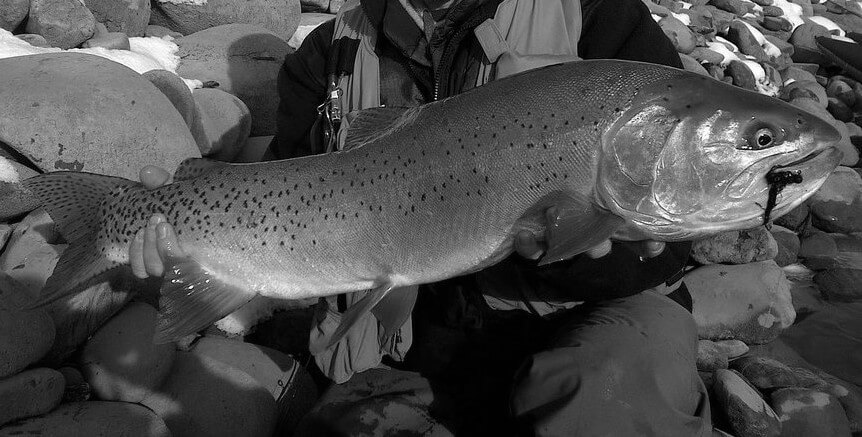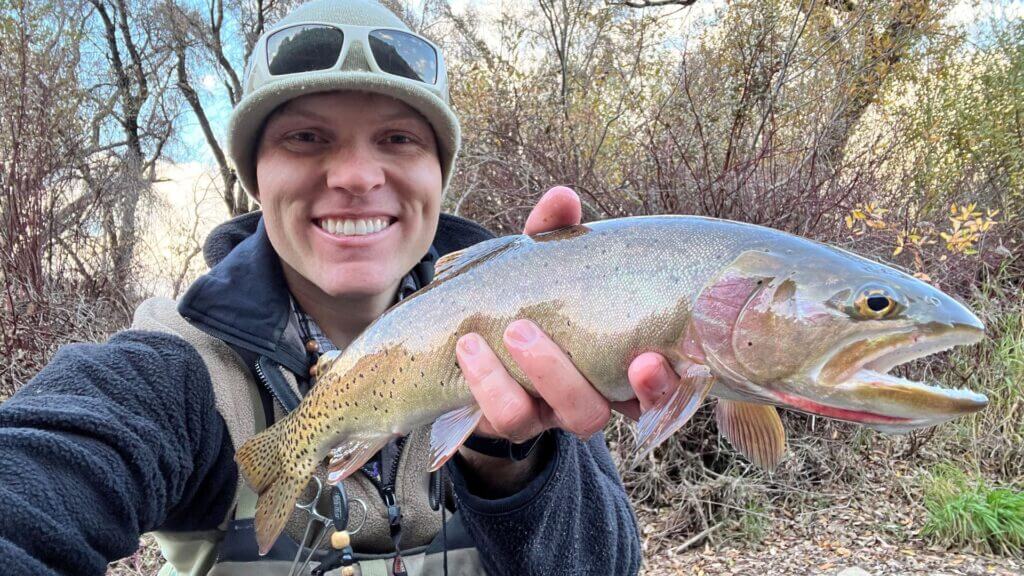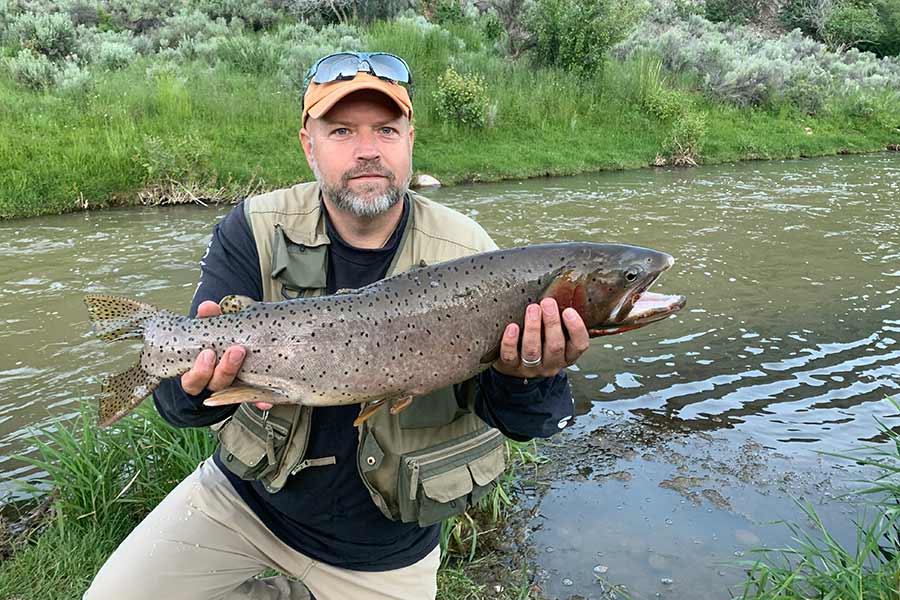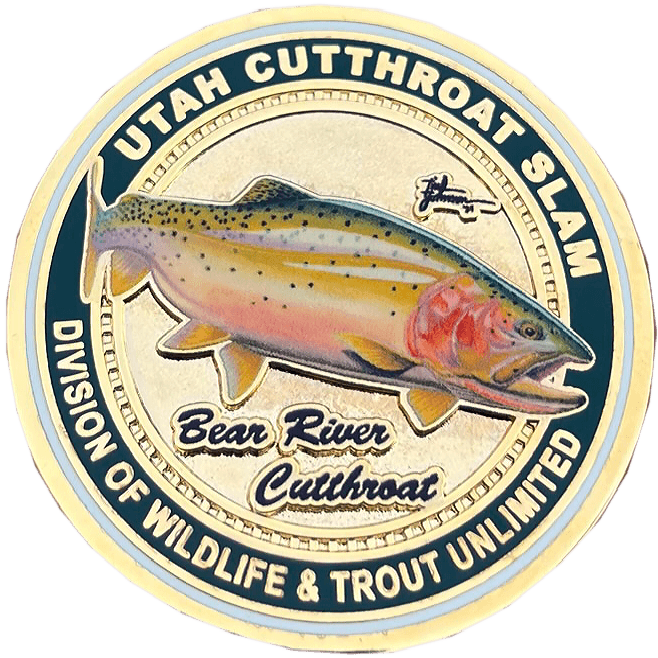
02 Feb Did Bonneville Cutthroat Ever Reach 40 Pounds?
By Hayden Cook
(Cover Photo – Photo of a 31½-inch non-native cutthroat caught by Curtis Robinson in East Canyon Reservoir in 2011)
When I first discovered the Utah Cutthroat Slam and learned about Utah’s four native subspecies of cutthroat trout, my curiosity was piqued. I wanted to dive deep into the world of these fish: where to find them, what set them apart, and how they had evolved into distinct subspecies. Armed with my undergraduate degree in biology and a passion for ecology and evolutionary sciences, I immersed myself in the study of Utah’s cutthroat trout.

One remarkable tidbit during my research always stuck with me: the claim that Bonneville cutthroat trout used to live in Utah Lake and could grow to a whopping 40 pounds. A 40-pound cutthroat trout in Utah? It sounded almost unbelievable. I couldn’t help but feel like I’d been born in the wrong era, missing out on a golden opportunity for fishing in Utah’s heyday. However, my skepticism started to kick in. Where did this astonishing fact originate? Why, despite decades of conservation efforts, had no one come close to encountering a Bonneville cutthroat of such colossal proportions? Could this legendary tidbit simply be a myth? Well, let me set the record straight: NO, Bonneville cutthroat trout never reached 40 pounds.

First, let’s delve into the history of Bonneville cutthroat in Utah. The Bonneville cutthroat trout (Oncorhynchus clarkii utah) once thrived in Lake Bonneville, an ancient lake that emerged after the last ice age, spanning around 20,000 square miles—comparable to the size of today’s Lake Michigan (22,410 sq mi). Over thousands of years, Lake Bonneville receded to its current remnants, the Great Salt Lake and Utah Lake. The saline waters of the Great Salt Lake can’t support fish life, but Utah Lake, a freshwater body, was home to a population of native trout, often referred to as “speckled trout” or “lake trout” by early pioneers. These Utah Lake Bonneville cutthroat led an adfluvial life, spending most of their existence in the lake, where they fed and grew as the apex predator. Come springtime, they migrated into the lake’s tributaries to spawn, perpetuating their population for thousands of years. Save for fish-eating birds and bears in rivers, the only pressure the cutthroat would have had was from Utah’s ancient peoples, who collected only as many fish as was necessary for their survival.

When early pioneers from The Church of Jesus Christ of Latter-day Saints (aka Mormon Pioneers) settled in the Utah territory in 1847, they quickly turned to trout from Utah Lake as a primary food source. Fishing was so prolific in the lake, that it evolved into a commercial fishery to sustain the growing population of Salt Lake City, mining camps, and surrounding communities. Fishermen used hooks or nets to catch these fish, but without regulations or rules set in place, some Utah Lake hauls in 1864 measured upwards of 3,500-3,700 lbs. in a single net. It was during this early era of pioneers that the fabled 40-pound cutthroat trout could supposedly be found in Utah Lake. A fish of that size would have provided sustenance for an entire family, even a Utah-sized one, for days or weeks!

Unfortunately, the relentless and poorly regulated fishing practices, combined with a lack of understanding of cutthroat populations’ sensitivity, led to a decline in trout numbers by the 1870s. Habitat destruction hindered Bonneville cutthroat spawning, resulting in reduced recruitment year after year. And agricultural runoff and other pollutants further deteriorated Utah Lake’s water quality. By 1933, the last Bonneville cutthroat trout in Utah Lake was caught, marking the end of this species in the lake.

Due to a variety of factors, Bonneville cutthroat were also nearly eradicated across the state. The introduction of non-native trout like brown and brook trout led to out-competition of some populations, while hybridization with introduced rainbow trout or non-native cutthroat led to many pure Bonneville strains being lost. By the 1950s, it was thought that Bonneville cutthroat had gone completely extinct. But after their rediscovery in the Deep Creek Mountains by Don Duff in 1974, and thanks to dedicated efforts by early fisheries biologists, Bonneville cutthroat went from only existing in less than 5 miles of streams, to repopulating about 41% of their historic range. A huge success story in conservation for this unique cutthroat subspecies. In 1997, the Bonneville cutthroat trout even received the honor of being recognized as Utah’s state fish.

But that brings us to the present, with the persistent “fact” that Bonneville cutthroats in Utah Lake could reach 40 pounds. Various websites and news sources, including Trout Unlimited, Hatch Magazine, Idaho Fish and Game, Deseret News, Salt Lake Tribune, Visit Utah, US Forest Service, and our very own Utah Cutthroat Slam website, mention this factoid. Yet, I found myself wondering about the source of this number, as it seemed almost too good to be true. Not a single Bonneville cutthroat trout in the past century, even after extensive restoration efforts, has come close to this 40-pound mark. The current state fishing record for a Bonneville cutthroat trout in Utah is held by Willie G. Carollo who caught a 28-inch specimen in 2022 from Lost Creek Reservoir, weighing in at 10 pounds and 2.24 ounces—only a quarter of the supposed record size for these fish. So, what’s the deal? Why aren’t Bonnevilles getting as large as they once could?

Fortunately for us, Dr. Henry Crécy “H. C.” Yarrow provided an invaluable report in 1874 which holds the key to debunking the 40-pound Bonneville myth. In his report titled “On the Speckled Trout of Utah Lake,” Dr. Yarrow provides a thorough and detailed account of Bonneville cutthroat and their condition during the 19th century in both Utah and Panguitch Lakes. In this report, Yarrow clarifies that even back then, the average size of a Bonneville from Utah Lake was 14 inches, with an average weight of 1.5 pounds. He also notes that the maximum size he personally observed and that he found upon local inquiry would be a Bonneville measuring 3 feet (36 inches) in length and weighing 15.5 pounds. Even in that historical context, a 30 to 40-pound Bonneville cutthroat was beyond the realm of possibility, with the average size of these fish generally being the same as what we find in today’s lake-dwelling specimens.

This revelation makes a lot of sense when you think about it. It is widely known that Lahontan cutthroat trout are the largest species of cutthroat in the world, with the Pilot Peak strain in Pyramid Lake, Nevada being known to grow particularly large. In fact, the world record cutthroat trout, a colossal 41-pounder, was caught in 1925 from Pyramid Lake. The Lahontan cutthroat simply possesses the genetics to reach monstrous sizes. As recently as 2021, an angler reeled in a 39-inch Lahontan from the lake, weighing 30 pounds 4 ounces. Now that’s a giant fish, especially for a cutthroat. Not only does this subspecies have it in their DNA to reach these record sizes, but it also has the proof, something that simply cannot be said for the Bonneville cutthroat.

So where did the legendary “30—40 lbs.” figure for Bonneville cutthroats in Utah Lake come from? One theory suggests it might be a mix-up between the Lahontan and Bonneville cutthroats. With that record Lahontan at 41 pounds, similar to the “40-pound Bonneville,” and Pyramid Lake sharing a similar history to Utah Lake (both experiencing extinctions of their respective cutthroat strains), it could be an error made by historians or anglers as they passed down large cutthroat stories. However, I think the truth behind the inaccurate fact goes back to Dr. Yarrow’s famous article.

In Yarrow’s report, he mentions the following, “The trout of Utah Lake may be taken at nearly all seasons by both hook and net at all times, but in Pangwitch Lake by hook only since fishing by any other way is prohibited by common consent. This, however, is no hardship, since large captures are easily made with the hook, I myself having taken from thirty to forty pounds weight in a single hour’s fishing.” There it is, did you catch it? “Thirty to forty pounds!” But did you notice what Dr. Yarrow was saying? He didn’t claim to catch a single trout that weighed 30 to 40 lbs.; he meant that within an hour, he cumulatively caught enough cutthroat to total 30 to 40 pounds in weight. Moreover, due to how the sentences are structured, he may have even been referring to Panguitch Lake, not Utah Lake, as being the location of this 30 to 40 pounds per hour claim. I believe this is where the confusion arose. That at some point, someone misinterpreted this quote and propagated the story that 30 to 40-pound Bonneville cutthroats once existed in Utah Lake. The truth is, they did not. Even Dr. Yarrow, a naturalist of his time, refutes the claim that the Bonneville cutthroat of Utah Lake could reach sizes of 30 to 40 pounds, with his mentioned maximum being only 15.5-pounds. And given the record size of Bonnevilles known today, along with the size of the fishery that was Utah Lake in the 1800s, I think this 15.5 pound maximum is a lot more accurate to what these fish can actually attain, rather than the far fetched claim of even 30 pounds.

In conclusion, if you’re on the hunt for a record-breaking 40-pound cutthroat trout, you’d do well to try Pyramid Lake, where enormous Lahontan cutthroat await. Utah’s Bonneville cutthroat trout will likely never grow to even half that size. Nevertheless, keep in mind that Utah is still home to some impressive cutthroat! Lost Creek Reservoir and Lost Creek itself hold the current Bonneville cutthroat catch-and-release and catch-and-keep state records. Yet even bigger cutties are out there if your cast your line in Bear Lake. A record-setting 31-inch Bear Lake cutthroat trout was caught in 2021, and there’s a good chance an even larger fish is still lurking out there, waiting to be hooked. So while you wont find a 40 lb monster cutthroat in Utah Lake, just know that Utah still has some excellent fishing opportunities if large cutthroat are the target species for your next fishing adventure!


Sources:
https://penbay.org/cof/cof_1872-1873_xii.pdf
https://wildlife.utah.gov/record-fish.html
https://www.nativetroutflyfishing.com/lahontancutthroat.htm
https://www.nativetroutflyfishing.com/bonnevillecutthroat.htm
https://www.fs.usda.gov/rm/pubs_rm/rm_gtr256/rm_gtr256_028_035.pdf

Terry Cook
Posted at 13:14h, 03 FebruaryLove this author. Great article.
Steve Houser
Posted at 17:57h, 29 SeptemberI suspect that IF Cutties over 20 pounds ever did exist, it was a subspecies that is lost to history. A huge amount of study has been conducted and there is no evidence that Utah Lake was ever cold enough or deep enough to carry any modern trout in Utah. In fact, except for more weed growth and less competition, there is little difference between the Utah Lake of today and 200 years ago. Bore samples indicate that Utah Lake is not silted in.
I suspect, that like Pyramid lake, a sub species had developed that could handle higher temperatures and higher salinity. YES, Utah Lake does have a slightly higher salinity then the rivers around it, mostly due to the huge amount of evaporation from the surface area ration to the total volume. I support improvement and restoration of Utah Lake, but if we want “trout” back in Utah Lake, we will, wait for it, …………………………need to introduce Cutties from Pyramid Lake, and even then they probably can’t handle it.
Considering the fact that we will never ever ever, and I mean never, introduce another non-native, potentially competing, Cutthroat trout into Utah again, the thought of it is nothing more then a metal excersize.